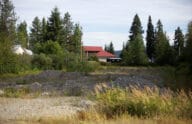And anyway . . . where is the environmental threat?
As pointed out in a previous post, one of the main arguments being put forward by the pro-EPA crowd in PLF’s case, Sackett v. EPA, is that Compliance Orders are necessary for the EPA to “promptly respond” to environmental harms, and that tying the EPA up in litigation would necessarily undermine EPA’s ability to save the environment. Even assuming for the sake of argument that this is true, one is left asking: so why did the EPA issue the Compliance Order in the Sacketts’ case?
As was pointed out by Professors Richard Frank and Richard Lazarus, no one–not the EPA, and not the NRDC and its fellow amici–has ever made the claim that the Sacketts’ landfill activities or any subsequent development they proposed caused or will cause any environmental harm. And to be honest: how could it? The Sacketts’ lot is a 0.63 acre parcel in Idaho’s panhandle. Priest Lake or not, exactly how much environmental damage does a half acre of clean fill dirt cause in rural Idaho, even if one were to concede that this sliver of property in fact contained some sort of wetlands?
Sure, Priest Lake is a beautiful, pristine lake. But let’s get things in perspective. The Sacketts’ lot is not even on the shore of Priest Lake. There is an entire row of houses between the Sacketts’ lot and Priest Lake–and none of those property owners on the lake ever had to get a wetlands permit. Here is a photo of a couple of those houses. Incidentally, there are rainwater drain pipes from some of these properties flowing directly into the lake. That strip of grass between the houses? If you walk 500 feet inland from the lake along that strip of grass, you will finally hit the Sacketts’ lot–after you cross a raised roadbed.
There are neighbors on either side of the Sackett property. None of those neighbors ever had to get a wetlands permit to build. There are roads on two sides of the Sackett lot. No permit was needed for building those roads. Yet the Sacketts’ lot, and that lot alone, will apparently affect the water quality of Priest Lake, Bonner County, and Idaho so severely that the Sacketts must restore their little lot to “nature” (that is, as natural as you can get it, considering it is surrounded by development and has an existing sewer hook-up) under a threat of over $100 million in fines and, as of now, still counting.
Priest Lake itself has about 26,000 acres of surface area. It is located entirely in Bonner County, which encompasses 1,919 square miles of land. The entire Bonner County population is only 40,877 residents, which means that the population density within the county is about 21 people per square mile of land–or, put another way, about 10,044 less people per square mile than the EPA’s paved hometown of Washington DC, located right on the shores of the navigable Potomac River, and 70,930 less people per square mile than the concrete jungle of Manhattan, surrounded by the navigable Hudson, East, and Harlem Rivers, where NRDC’s headquarters is located. In fact, the population of the entire state of Idaho is about 40,000 less than Manhattan; only Idaho has about 83,500 square miles more of land. When you get right down to it, EPA ‘s presence in Idaho does not seem to be aiming very accurately at the heart of our nation’s clean water woes.
It is difficult to imagine that anyone would seriously allege that the situation the Sacketts’ find themselves in is why Congress so urgently passed the Clean Water Act. And it is risible for the NRDC or the EPA seriously to contend that the use of a Compliance Orders in this case was warranted, let alone necessary.
In sum, whatever the utility of the Compliance Order is theoretically as an enforcement tool, the EPA uses them not merely when the environment is under dire threat of being irreparably harmed, but because the Orders are inherently coercive, which the Justices of the Supreme Court clearly recognized in their questioning of the EPA at oral argument. The EPA is perfectly capable of enforcing the Clean Water Act in ways that do not violate the due process rights of landowners; however, it chooses to ignore those methods.
The fact is, a ruling in favor of the Sacketts will do nothing to undermine the EPA’s ability to respond to legitimate environmental threats. We can only hope that it will undermine EPA’s ability to shakedown and intimidate landowners where their authoritarian tactics and justification for action are, to put it mildly, highly questionable.



